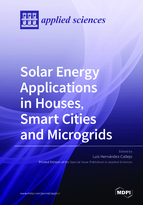Solar Energy Applications in Houses, Smart Cities and Microgrids
A special issue of Applied Sciences (ISSN 2076-3417). This special issue belongs to the section "Energy Science and Technology".
Deadline for manuscript submissions: closed (30 June 2019) | Viewed by 19856
Special Issue Editor
Interests: energy; engineering; computer science; photovoltaic systems; microgrids; distributed generation; smart metering
Special Issues, Collections and Topics in MDPI journals
Special Issue Information
Dear Colleagues,
This Special Issue aims to present the reality of renewable energy sources, specifically those based on solar energy. This reality focuses on the integration of solar energy in cities (Smart Cities), buildings (Smart Buildings), microgrids, smart Rural Grids, and other similar environments. The applicability of solar energy is fundamental for the sustainable development of the previous infrastructures. Therefore, the topics of interest of this Special Issue are as follows:
- The integration of photovoltaic systems in cities, buildings, and microgrids.
- The hybridization of photovoltaic systems with electrical storage.
- The hybridization of photovoltaic systems with other energy sources.
- Monitoring tools for systems based on solar energy.
- Tools to improve efficiency in systems based on solar energy.
- The integration of thermal systems in cities, buildings, and microgrids.
- The prediction of solar resources for the estimation of small-scale photovoltaic production.
- Artificial Intelligence applied to the management and operation of solar systems.
Prof. Dr. Luis Hernández-Callejo
Guest Editor
Manuscript Submission Information
Manuscripts should be submitted online at www.mdpi.com by registering and logging in to this website. Once you are registered, click here to go to the submission form. Manuscripts can be submitted until the deadline. All submissions that pass pre-check are peer-reviewed. Accepted papers will be published continuously in the journal (as soon as accepted) and will be listed together on the special issue website. Research articles, review articles as well as short communications are invited. For planned papers, a title and short abstract (about 100 words) can be sent to the Editorial Office for announcement on this website.
Submitted manuscripts should not have been published previously, nor be under consideration for publication elsewhere (except conference proceedings papers). All manuscripts are thoroughly refereed through a single-blind peer-review process. A guide for authors and other relevant information for submission of manuscripts is available on the Instructions for Authors page. Applied Sciences is an international peer-reviewed open access semimonthly journal published by MDPI.
Please visit the Instructions for Authors page before submitting a manuscript. The Article Processing Charge (APC) for publication in this open access journal is 2400 CHF (Swiss Francs). Submitted papers should be well formatted and use good English. Authors may use MDPI's English editing service prior to publication or during author revisions.
Keywords
- photovoltaic systems
- thermal systems
- artificial intelligence
- monitoring and operation






